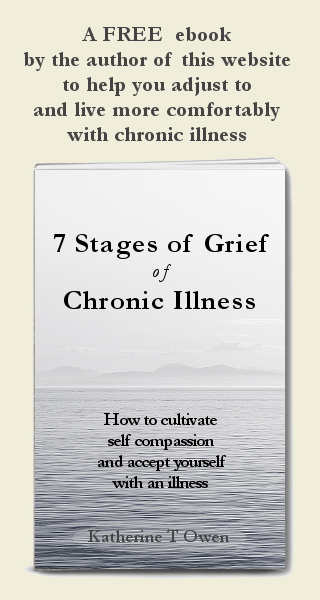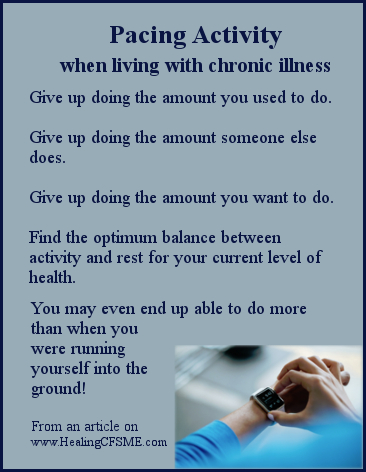Pacing Activity
with Chronic Fatigue Syndrome
This article gives advice on pacing activity when living with Chronic Fatigue Syndrome ( CFS ). The same advice applies to those living with Myalgic Encephalomyelitis.
Pacing is also appropriate when living with many different chronic illnesses or with chronic pain.
Or click here to CHOOSE FROM
A RANGE OF personalizable cards and gifts.
The healing-themed gifts are designed by myself, Katherine, the author of
this website HealingCFSME.com
Proceeds go towards the cost of the website. Thank you. Enjoy!
Contents for this CFS article
Scroll down to the item of interest:
- Pacing Activity - Definition
- Understanding the need to pace activity
- Pacing for health management
- The benefits of pacing yourself
- There will be times when it is not possible to pace activity
- But I just want to do something normal and nice!
- Using a timer to manage activity levels
- Switching
- Relationships and illness management
Pacing Activity - Definition
Pacing activity is a health management approach which divides activity and rest into manageable chunks, appropriate for your unique level of health.
Understanding the need for pacing activity
How to understand the need to pace activity.
When you are healthy you might aim to sleep for 8 hours a night. If, instead, you stay up for a whole night and then try to sleep for 16 hours the night after that, there are consequences for your well-being and it takes you time to recover.
You understand that you need to alternate activity with a time of rest.
When you live with a lower level of health, your level of sustainable activity has reduced. It might reduce to being able to keep going for two hours. With severe Chronic Fatigue Syndrome it might reduce to being able to keep going for only a few minutes.
You might say "I will just do a bit more and then I will spend time recovering". But recovery might take far longer (or not happen) if you push yourself beyond the right amount of activity or exercise for you.
Another example to understand pacing...
Another example to help you understand the need to pace activity is to think of an old car that is not working well. It can travel two miles and then overheats and has to take considerable time to cool down.
By travelling only two miles at a time and taking breaks you could potentially avoid over heating and travel a long distance, even in your old car.
Sorry to compare you/me to an old car! But I have found both these examples useful when explaining to other people (or to myself) why when living with Chronic Fatigue Syndrome / Myalgic Encephalomyelitis I need to stop NOW! not later.
Pacing activity is an excellent way of making the most of the health you have.
For me, pacing activity and a diet which helps you to avoid periods of dizziness are both essential health management approaches.
Pacing for health management
Pacing activity allows you to find the optimum balance between activity and rest for the level you are at.
Give up doing the amount you used to do.
Give up doing the amount someone else does.
Give up doing the amount you want to do.
Find an amount of activity which is realistic for your level of health.
You may even end up able to do more than when you were running yourself into the ground!
Receive daily inspiration...
by putting your favorite (favourite) healing quote on
a mug, cushion, postcard, coaster, T shirt etc.
You will find my zazzle gift store at
zazzle.com/HealingStore.
Use one of my designs or start from a blank.
Thank you from me, Katherine, author of HealingCFSME.com
The benefits of pacing yourself
The benefits of pacing activity and doing a realistic amount are as follows:
- When you pace out your energy, you can more easily maintain
your current level of health.
- Relieve fear. When you establish greater stability of health it can help to relieve any fear you might have that the illness will get
worse. Fear and stress can exacerbate health problems, so it is great if you can keep them as low as possible.
- Give your body a chance to heal. Your body
has the ability to heal itself. By giving it both periods of rest and periods of
activity you give it the best chance to heal.
- You are able to complete more tasks reliably which brings satisfaction.
A small task achieved is still a task achieved. You have the satisfaction of a goal set and reached. - Reliability
helps you in your relationships.
A loved one can potentially adapt to you doing less, but it is harder to adapt when they don't know how much you can or can't do.
Relationships are important and even more important when living with illness.
(I know it may be tough, if not impossible, to find a sustainable level of activity. One of the demands of living with chronic illness is that you don't know how much you can or can't do. But at least, with realistic goals, you can go in the direction of becoming more consistent.)
- By having regular rest and activity you avoid the frustration of unnecessary periods of inactivity.
If you wear yourself out and can then do nothing you are left with the distress of feeling more ill and dealing with more symptoms.
We know how horrid that is.
Also, when the symptoms of chronic illness are higher, it is harder for you to keep hope for healing alive. - By having regular rest and activity you avoid any unnecessary loss of muscle strength from periods of inactivity. (Please know that some reduction in activity is likely and appropriate when living with a chronic illness such as ME/CFS.)
There will be times when pacing activity is not possible
There will be times when you cannot pace activity. Please be gentle on yourself when you cannot do so.
For myself, when I was at my most ill, interaction with the caregivers within a restricted time period pushed me outside my limits almost every day, but I needed to do this to survive.
Now I am at a higher level of health, I may work too long on a book or a website, or find that I take longer than I would like to recover after an outing.
You may find it hard to pace yourself because you have children who need looking after.
Relationship challenges may push you to do more than is comfortable.
You may still have a job and have to push yourself too hard and then spend time recovering.
You may feel isolated and prefer to see a friend even if the exertion leaves you taking time to recover.
But I just want to do something normal and nice!
You may ignore the discipline of pacing yourself at times because you want to give yourself a 'treat' of doing something nice or feeling normal.
This is a wonderful
sign of your enthusiasm for life. And I suggest that you do so at times.
But ask yourself: if you
had a friend whose idea of a treat always involved you ending up in
pain, would you look forward to their 'treats'. I am guessing, you might
get fed up after a while.
You can learn to feel good about treating yourself well.
You can enjoy the benefits of feeling better as a result.
But yes, if you go for it and do something anyway, enjoy it!
It takes discipline to pace activity when living with Chronic Fatigue Syndrome. At times you will feel frustrated and sorry for yourself. This is normal. Do what you can. Forgive yourself when you don't do it perfectly.
Also, be realistic.
The aim of pacing activity is to to find a more sustainable level of functioning. But if you live with chronic illness, your condition may well fluctuate in ways you can't predict. Successful pacing can help to give you a life with fewer bumps, but there are still likely to be bumps in your health along the way.
Using a timer to manage activity levels
Whilst living with very severe Chronic Fatigue Syndrome / Myalgic Encephalomyelitis, my life changed for the better when I took pacing activity seriously enough to start using a timer. I allocated 5 to 10 minutes of the hour to activity of some (restricted) kind.
As a result, I learned to keep the arm pain below crying-at-the-pain level, and keep my eyesight at the point where I could often focus on someone’s face whilst they were talking.
Whether or not it is useful to use a timer will depend on your level of chronic illness as well as your character tendencies.
For me, the timer gave me the freedom to lose myself in an activity without trying to simultaneously be aware of how my body was feeling. Using a timer increased my sense of freedom and reduced my need to focus on symptoms.
For someone else, using a timer may lead to too much rigidity. And, if you are well enough to enjoy an activity without having to be too time aware, it may be better to do this.
Switching
Along with pacing you may also find it helpful to engage in the health management approach of switching.
Switching Definition:
A health management approach to switch between using different muscle groups or between cognitive and non-cognitive activities.
I love switching.
Pacing to the extent I need to do so doesn't allow for as much busy-ness as I would like.
In particular, my eyes and my fingers require stricter pacing than the rest of me, especially because I like to be on the computer working on this website or on one of my books.
Sometimes I break up the time by engaging in a self healing technique such as EFT tapping. Sometimes, I lie down and listen to a subliminal CD.
But sometimes, I can alternate by preparing the next meal, or washing up after the previous one. I can then return to using my eyes or fingers for a little longer.
Interestingly, switching is advised as an approach for good management of one's time even when healthy. We concentrate on a task best when we give ourselves breaks to do something else, and especially when we engage in a task which uses a different part of the brain.
If you are at a level of being able to engage in exercise then alternate cognitive tasks with short bursts of exercise.
Relationships and illness management
You will often need the cooperation of people in your life - family, friends or carers - in order to better manage your health. Unfortunately, it is hard for a healthy person to understand the need for pacing activity.
It may feel at times that people disbelieve that you need the help you are asking for. That is not necessarily the case, but either way, if you do feel distress you can take it as an opportunity to affirm your own self-belief.
You can only do what you can do. And what you can do is enough.
Wishing you health both within and beyond illness,
Katherine
Katherine T Owen runs this website - www.HealingCFSME.com.
She is author of the booklet of 15 poems, Be Loved, Beloved
(Read it in paperback at lulu.com or on kindle)
- ME/CFS Coach Simon Pimenta has a great video encouraging us to recognise and adapt our behaviour to our energy level.
- Action for ME (Myalgic Encephalomyelitis) is a support group in the UK. They provide a useful pamphlet to help people with Chronic Fatigue Syndrome and ME to pace activity.
Click on the middle link below for advice on cultivating Coping skills when living with chronic illness.
- Home Page
- CFS and Exercise
- Pacing Activity
 |
© Katherine T Owen. All articles on this website are copyrighted. I am delighted if you choose to click above to share this page on social media, but please
do not copy, print or otherwise use without my permission. Thank you. Disclaimer:
I am not a medical practitioner. The articles on this website are not
to be taken as medical advice. Please consult a medical practitioner as
necessary. |











